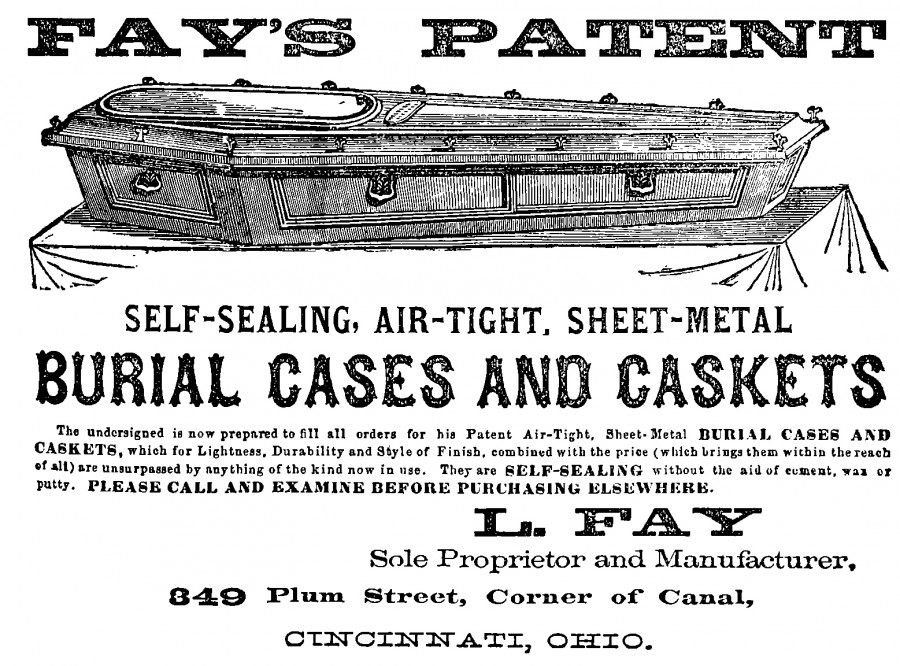The Cincinnati Gazette [28 January 1867] was in full harrumphing mode: “Fashion affects the price of coffins. A dealer says that, since the introduction of caskets, he can hardly give away his stock of old-fashioned coffins.”

Digitized by the Public Library of Cincinnati and Hamilton County; image extracted from PDF by Greg Hand
Time was, Cincinnatians were buried where they died. No one was embalmed, and coffins were very plain and almost exclusively made of wood. Burial followed death so rapidly that, even through the dog days of summer, there was little fear of decomposition because burial was so soon after death. Most coffins were slapped together as a sideline by furniture makers.
The Civil War inspired a revolution in American funeral practices, including the preference for newfangled caskets over scary old coffins. In his book, Grave Matters: A Journey Through the Modern Funeral Industry to a Natural Way of Burial, Mark Harris describes how thousands of dead soldiers were shipped home to families who wanted to see their departed loved ones before burial. Entrepreneurs rushed to find better and more effective embalming techniques and radically innovative coffins to meet the demand.
Following the Civil War, America industrialized at a rapid pace, more people moved west to seek their fortunes, and communication by telegraph and newspaper improved dramatically. More and more families delayed funerals to allow distant mourners to travel to the burial site. One Cincinnati company acknowledged the new requirements while touting the features of its newly designed casket:
“A delay of days or weeks, awaiting the arrival of absent friends, is entirely practicable. When due attention is given in sealing, which may, with care, be accomplished by anyone . . . bodies may be carried to any part of the globe at any season of the year, with perfect safety.”
To accommodate these changing trends, Cincinnati manufacturers rushed to create new types of burial cases. Kevin Grace, in his book, Cincinnati Cemeteries: The Queen City Underground, describes one of the most successful local firms:
“In 1853, Martin Crane and Abel Breed went into business together to manufacture cast-iron burial cases and hearses. Located on West Eighth Street in Kingsgate, the Crane and Breed Casket Company was the first to introduce a shoulder-type zinc casket in 1857. In 1862, the company introduced a rectangular box-shaped casket, which was chosen for President Lincoln’s burial in 1865.”

Digitized by the Public Library of Cincinnati and Hamilton County ; image extracted from PDF by Greg Hand
Crane and Breed took great pains to ensure that their customers knew they did not produce coffins. Their advertising underlined the distinction in the most forceful way:
“Under their present improvements these burial cases are entirely free from those revolting suggestions which have heretofore been connected with their name. The metallic burial casket is entirely devoid of those unpleasant associations which usually accompany the form of a coffin.”

Advertisement for John P. Epply Undertaker, from Williams Cincinnati City Directory 1860
Digitized by the Public Library of Cincinnati and Hamilton County, Image extracted from PDF by Greg Hand
Almost invariably, the new caskets featured windows, at least framing the face of the deceased. In some models, the entire top of the casket was glass. Until the funeral industry perfected embalming techniques in the later years of the nineteenth century, “viewings” were conducted through the glass windows of the casket, the air-tight containers holding all unpleasant smells inside. Well, almost. As Mark Harris notes:
“Encasing a corpse inside an airtight metal casket might delay its decay, but . . . the caskets were expensive and even when procured offered no guarantee against the effects of putrefaction. Gases from the decaying corpse could build up inside the airtight container and eventually blow it – and the remains inside – apart.”
Embalming was uncommon in the middle of the nineteenth century. Only anatomy professors embalmed cadavers and then only to maintain them as laboratory and instructional specimens. Clarke’s Cincinnati College of Embalming, founded in 1882 by John Henry Clarke, was the first such college in the United States and a milestone in the development of the professional funeral industry. Theodore W. Eversole of the Cincinnati Historical Society has remarked on Cincinnati’s pioneering role:
“Cincinnati’s contribution to the profession is best witnessed by the number of undertaking establishments, founded in the Nineteenth Century, which have managed to evolve into the modern mortuaries of today. In some cases these businesses represent some of the oldest family enterprises in the city. Funeral homes such as Schaefer & Busby, Inc. (1836), Fuldner Mortuary (1845), Neidhard-Minges Funeral Home (1860), Charles A. Miller Sons (1870), John J. Gilligan & Sons (1877), Peter Rebold & Son, Inc. (1882), and the Busse and Borgmann Company (1895) are a few of the prominent local examples.”
As the industry ramped up, though, it sure produced some extraordinary caskets.
This article was reposted with permission from Greg Hand, editor of Cincinnati Curiosities





Facebook Comments